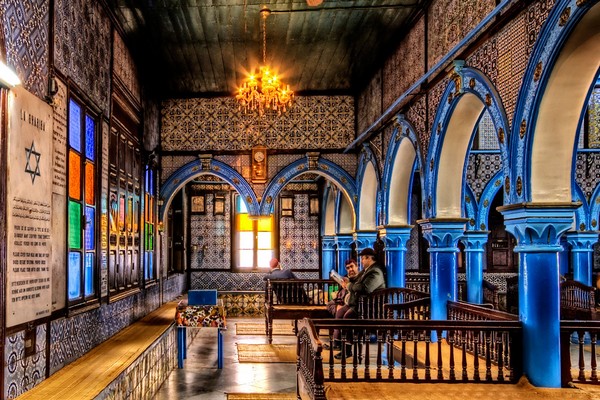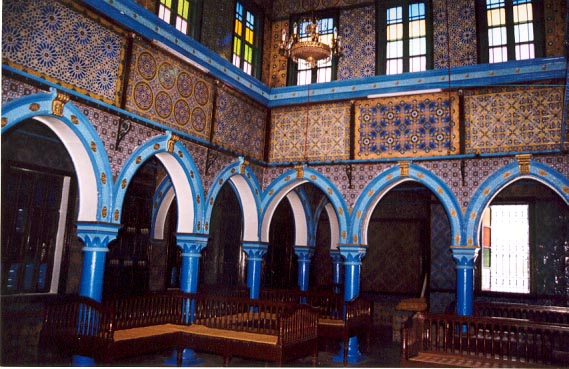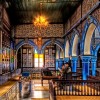Djerba has become renowned for its tourism over the years and anyone who does visit this area will most likely be tempted by the El Ghriba Synagogue.

This is regarded as one of the most holy attractions in the whole of Tunisia and is actually the most famous of around twenty synagogues and prayer houses that are based around Djerba.
Past visitors to the synagogue are blown away by its beauty, charm and history. Bearing this in mind, we’ll now take a look at some of the history of the attraction and showcase what it’s all about.
What are the beginnings of the synagogue?
Unsurprisingly, there is more than one tradition that attempts to explain the beginnings of El Ghriba Synagogue.
The main one focusses around the establishment of one of the early Jewish settlements on the Island of Djerba. It’s understood that a group from the destroyed First Temple of Jerusalem brought a door and a stone from the alter of the temple in 586 BCE, which contributed to the construction of this synagogue.
There is at least some substance to this tradition, considering the fact that a stone is incorporated into one of the arches of the synagogue which is supposedly from this group of settlers.
Of course, this isn’t the only tradition. Another one suggests that the synagogue was built at some point during the first half of the 19th Century, with the site previously occupying a cabin that housed a beautiful, yet mysterious, young girl who had never been accepted by the locals.
It is suggested that when the girl died in a fire, the Jews of Djerba labelled her as a saint and built the synagogue in her name, where she once resided.
The final tradition is a slightly alternate version of the previous one and again focusses on the same girl. This time it suggests that she was a Jewish refugee who had arrived from Israel, bringing a Torah scroll and stone from the Temple of Jerusalem in the process.
When she arrived at the site, she is said to have died from exhaustion from her travels and the synagogue was therefore built in her memory.
How is the synagogue structured?

History suggests that the synagogue was built at some point during the second period of the 19th Century. While some traditions may suggest otherwise, the state of the site indicates that it previously housed another structure.
There are some historical anecdotes which indicate that something else existed in the early 16th Century. It was at this point that it was apparently destroyed by the Spanish military, only to be re-constructed at some point in the century.
The synagogue is structured like a lot of others in the area; boasting an inner courtyard and rooms which are constructed on arches and columns.
The nearby buildings were once used as accommodation for the pilgrims, with one of these only being erected in the early 1950s.
Other notable comments about the structure of El Ghriba Synagogue are that it doesn’t have an open-air praying hall. This is in stark contrast to a lot of other synagogues in the area, with El Ghriba having two that are both covered.
It’s understood that one of these may have once been an open courtyard which was then converted to a roofed room due to the high volume of people that used it. The two praying halls are linked by three arches.
The number of windows inside El Ghriba used to be significant; with twelve existing as this symbolised the twelve tribes of Israel.
However, if you are to visit the synagogue now, you will now see many more. This is due to recent renovations which have increased the size of the building.
Another interesting fact regarding the construction of El Ghriba is the two rows of columns which divide the main praying hall into three aisles. Quite interestingly, the final column is missing, with some under the belief that it was never constructed. Many believe that this is an act of remembrance in relation to the destruction of the Temple of Jerusalem.
How is the synagogue managed?

It goes without saying that the synagogue is one of the most important sites in the whole of Tunisia, and is therefore strictly managed.
Since the end of the 19th century, it has been managed by an independent administrative committee. While the upkeep of the synagogue is something that obviously falls within their remit, their main priority is to organize the pilgrimage to El Ghriba. This isn’t just for a religious perspective either; the pilgrimage is a huge source of income and has been for many years.
The annual pilgrimage

Following on from the above, the annual pilgrimage is something that El Ghriba Synagogue is mainly renowned for. It takes place during Lag Ba’Omer, with the festivities commencing on 14 lyar right the way through to 18 lyar.
The dates are significant for two reasons; the first is that the day of commencement coincides with the death of Rabbi Meir Ba’al HaNess, while the end day is the remembrance day for Rabbi Shimon Bar Yochai.
While the pilgrimage will involve visits to numerous prayer houses through the area, the visit to the synagogue is regarded as one of the most crucial parts of the festivities.
Tourism and the modern day synagogue
Unfortunately, while the synagogue is a spectacular and undoubtedly holy attraction, it has been through some tough times.
It’s no secret that Djerba’s Jewish community is dwindling and this has resulted in some of the remaining Jews being targeted by locals who have differing religious views.
There was an attack at the Simchat Toah festival in 1985, which resulted in three people being killed. More recently, in 2002, a suicide bomber killed 21 people after driving a gas truck near to the perimeter.
Nevertheless, the synagogue still attracts a healthy number of tourists and is seen as one of the key attractions of Djerba. Many are intrigued to its history and architecture and some will come from all over the world just to see it.

